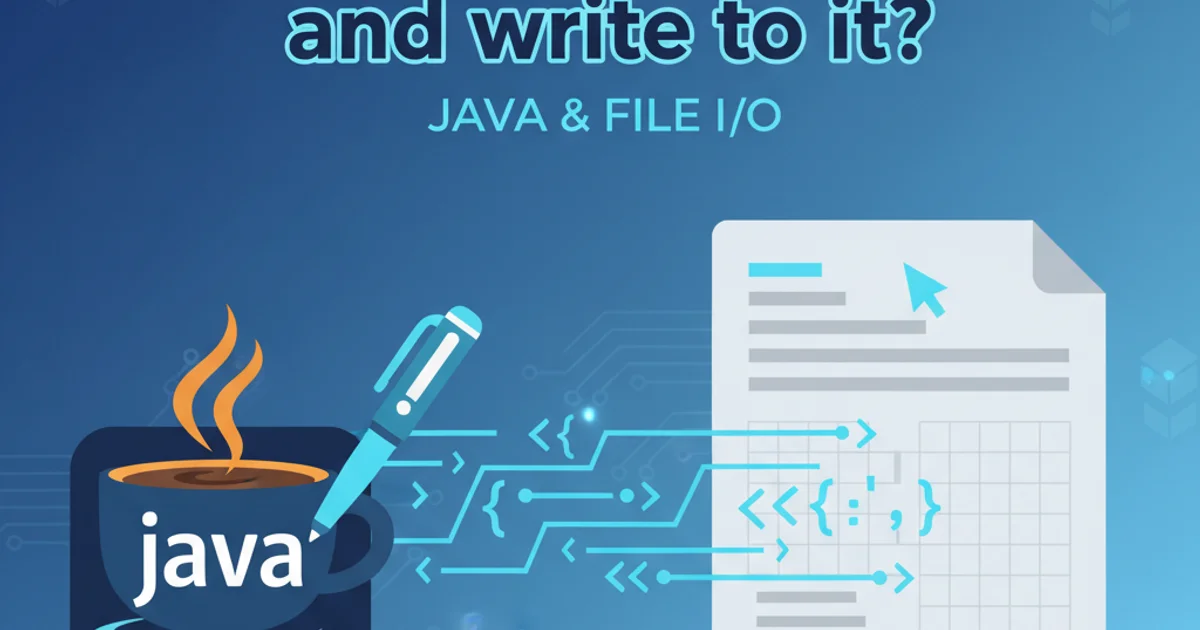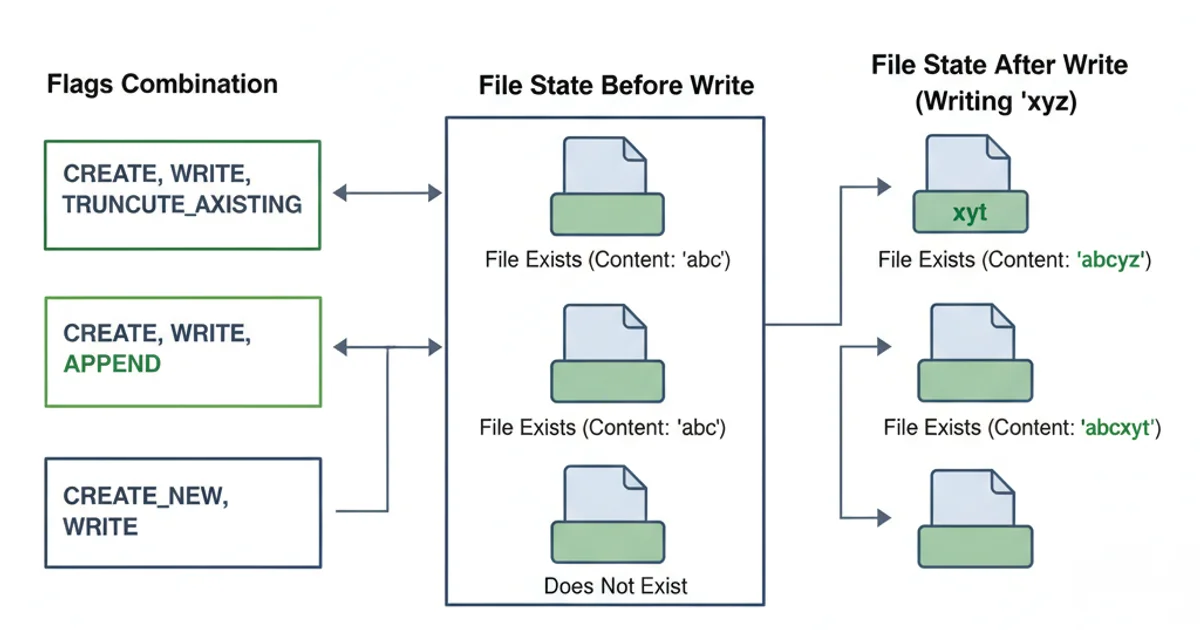How do I create a file and write to it?
Categories:
How to Create and Write to a File in Java

Learn the fundamental techniques for creating new files and writing data to them using Java's I/O streams and utility classes.
File I/O is a core capability in most programming languages, and Java provides a robust set of classes for interacting with the file system. This article will guide you through the process of creating new files and writing various types of data to them, covering both traditional I/O streams and modern NIO.2 approaches. Understanding these concepts is crucial for applications that need to persist data, generate reports, or handle configuration files.
Understanding Java File I/O Basics
Before diving into code, it's important to grasp the fundamental concepts of Java's file I/O. Java treats files as streams of bytes or characters. The java.io package contains classes for stream-based I/O, while java.nio.file (NIO.2) offers a more modern, path-oriented approach with improved error handling and performance for certain operations. When writing to a file, you typically need to:
- Specify the file path: This can be an absolute or relative path.
- Choose a writing mechanism: This determines how data is written (byte by byte, character by character, or in larger blocks).
- Handle exceptions: File operations can fail for various reasons (e.g., permissions, disk full, invalid path).
- Close the stream/writer: This releases system resources and ensures all buffered data is written to the file.
flowchart TD
A[Start] --> B{File Path Specified?}
B -- No --> C[Error: Invalid Path]
B -- Yes --> D{File Exists?}
D -- Yes --> E{Overwrite or Append?}
D -- No --> F[Create New File]
E -- Overwrite --> F
E -- Append --> G[Open File in Append Mode]
F --> H[Open File for Writing]
G --> H
H --> I[Write Data]
I --> J{More Data?}
J -- Yes --> I
J -- No --> K[Close File Stream]
K --> L[End]
C --> LBasic File Writing Process Flow
Writing Text to a File
The most common scenario is writing human-readable text to a file. Java offers several ways to achieve this, primarily using FileWriter and BufferedWriter for character streams, or Files.write() for simpler cases with NIO.2. Using try-with-resources is highly recommended to ensure that streams are automatically closed, even if errors occur.
import java.io.BufferedWriter;
import java.io.FileWriter;
import java.io.IOException;
import java.nio.file.Files;
import java.nio.file.Path;
import java.nio.file.Paths;
import java.nio.file.StandardOpenOption;
import java.util.Arrays;
import java.util.List;
public class FileWriteExamples {
public static void main(String[] args) {
String fileName = "my_output.txt";
String content = "Hello, Java File I/O!\nThis is a new line.";
List<String> lines = Arrays.asList("Line 1", "Line 2", "Line 3");
// --- Method 1: Using FileWriter and BufferedWriter (Traditional I/O) ---
System.out.println("Writing using BufferedWriter...");
try (BufferedWriter writer = new BufferedWriter(new FileWriter(fileName))) {
writer.write(content);
System.out.println("Successfully wrote to " + fileName);
} catch (IOException e) {
System.err.println("Error writing with BufferedWriter: " + e.getMessage());
}
// --- Method 2: Using Files.write (NIO.2) for a single string ---
String nioFileName = "nio_output.txt";
System.out.println("\nWriting using Files.write (single string)...");
Path nioPath = Paths.get(nioFileName);
try {
Files.write(nioPath, content.getBytes()); // Writes bytes, default creates/overwrites
System.out.println("Successfully wrote to " + nioFileName);
} catch (IOException e) {
System.err.println("Error writing with Files.write (string): " + e.getMessage());
}
// --- Method 3: Using Files.write (NIO.2) for a list of lines ---
String nioLinesFileName = "nio_lines_output.txt";
System.out.println("\nWriting using Files.write (list of lines)...");
Path nioLinesPath = Paths.get(nioLinesFileName);
try {
Files.write(nioLinesPath, lines, StandardOpenOption.CREATE, StandardOpenOption.TRUNCATE_EXISTING);
System.out.println("Successfully wrote to " + nioLinesFileName);
} catch (IOException e) {
System.err.println("Error writing with Files.write (lines): " + e.getMessage());
}
// --- Method 4: Appending to an existing file ---
String appendFileName = "append_output.txt";
String appendContent = "\nThis content is appended.";
System.out.println("\nAppending to " + appendFileName + "...");
try (FileWriter fw = new FileWriter(appendFileName, true); // true for append mode
BufferedWriter bw = new BufferedWriter(fw)) {
bw.write(appendContent);
System.out.println("Successfully appended to " + appendFileName);
} catch (IOException e) {
System.err.println("Error appending: " + e.getMessage());
}
// --- Method 5: Appending with NIO.2 ---
String nioAppendFileName = "nio_append_output.txt";
String nioAppendContent = "\nNIO.2 appended content.";
Path nioAppendPath = Paths.get(nioAppendFileName);
try {
// Ensure file exists for append, or create it if not
Files.write(nioAppendPath, nioAppendContent.getBytes(),
StandardOpenOption.CREATE, StandardOpenOption.APPEND);
System.out.println("Successfully appended to " + nioAppendFileName);
} catch (IOException e) {
System.err.println("Error appending with NIO.2: " + e.getMessage());
}
}
}
try-with-resources when dealing with I/O streams. This ensures that resources like FileWriter or BufferedWriter are automatically closed, preventing resource leaks and potential data corruption, even if exceptions occur during writing.Writing Binary Data to a File
For non-textual data, such as images, audio, or serialized objects, you'll typically use byte streams. FileOutputStream is the primary class for writing raw bytes to a file. You can wrap it with BufferedOutputStream for improved performance by reducing the number of physical write operations to the disk.
import java.io.BufferedOutputStream;
import java.io.FileOutputStream;
import java.io.IOException;
import java.nio.file.Files;
import java.nio.file.Path;
import java.nio.file.Paths;
public class BinaryFileWriteExample {
public static void main(String[] args) {
String fileName = "binary_data.bin";
byte[] data = {0x01, 0x02, 0x03, 0x04, 0x05, 0x06, 0x07, 0x08, 0x09, 0x0A};
// --- Method 1: Using FileOutputStream and BufferedOutputStream ---
System.out.println("Writing binary data using BufferedOutputStream...");
try (FileOutputStream fos = new FileOutputStream(fileName);
BufferedOutputStream bos = new BufferedOutputStream(fos)) {
bos.write(data);
System.out.println("Successfully wrote binary data to " + fileName);
} catch (IOException e) {
System.err.println("Error writing binary data: " + e.getMessage());
}
// --- Method 2: Using Files.write (NIO.2) for bytes ---
String nioBinaryFileName = "nio_binary_data.bin";
System.out.println("\nWriting binary data using Files.write (NIO.2)...");
Path nioBinaryPath = Paths.get(nioBinaryFileName);
try {
Files.write(nioBinaryPath, data);
System.out.println("Successfully wrote binary data to " + nioBinaryFileName);
} catch (IOException e) {
System.err.println("Error writing binary data with NIO.2: " + e.getMessage());
}
}
}
FileOutputStream, BufferedOutputStream) and not character streams (FileWriter, BufferedWriter). Using character streams with binary data can lead to data corruption due to character encoding conversions.Advanced File Writing Options
Java's Files.write() method (NIO.2) offers powerful options through StandardOpenOption enums, allowing fine-grained control over file creation and writing behavior. These options can be combined to achieve specific outcomes.

Common StandardOpenOption flags for Files.write()
import java.io.IOException;
import java.nio.file.Files;
import java.nio.file.Path;
import java.nio.file.Paths;
import java.nio.file.StandardOpenOption;
public class AdvancedFileWriteOptions {
public static void main(String[] args) {
String fileName = "advanced_output.txt";
Path filePath = Paths.get(fileName);
String initialContent = "Initial content.\n";
String appendContent = "Appended content.\n";
String createNewContent = "Content for a new file.\n";
// 1. Create a new file, fail if it exists (CREATE_NEW)
System.out.println("\nAttempting to create a new file (CREATE_NEW)...");
try {
Files.write(filePath, createNewContent.getBytes(), StandardOpenOption.CREATE_NEW);
System.out.println("Successfully created new file: " + fileName);
} catch (IOException e) {
System.err.println("Error creating new file: " + e.getMessage());
}
// 2. Write/overwrite content (CREATE, TRUNCATE_EXISTING)
System.out.println("\nWriting/overwriting content (CREATE, TRUNCATE_EXISTING)...");
try {
Files.write(filePath, initialContent.getBytes(),
StandardOpenOption.CREATE, StandardOpenOption.TRUNCATE_EXISTING);
System.out.println("Successfully wrote/overwrote to " + fileName);
} catch (IOException e) {
System.err.println("Error writing/overwriting: " + e.getMessage());
}
// 3. Append content (APPEND)
System.out.println("\nAppending content (APPEND)...");
try {
Files.write(filePath, appendContent.getBytes(), StandardOpenOption.APPEND);
System.out.println("Successfully appended to " + fileName);
} catch (IOException e) {
System.err.println("Error appending: " + e.getMessage());
}
// 4. Create directories if they don't exist (CREATE, CREATE_PARENTS)
String dirFileName = "temp_dir/nested/file.txt";
Path dirFilePath = Paths.get(dirFileName);
System.out.println("\nCreating file with parent directories (CREATE, CREATE_PARENTS)...");
try {
Files.createDirectories(dirFilePath.getParent()); // Ensure parent directories exist
Files.write(dirFilePath, "Content in nested dir.".getBytes(), StandardOpenOption.CREATE);
System.out.println("Successfully created file in nested directory: " + dirFileName);
} catch (IOException e) {
System.err.println("Error creating file in nested directory: " + e.getMessage());
}
}
}
StandardOpenOption.CREATE_NEW option is particularly useful when you want to ensure that you are creating a file that absolutely did not exist before. If the file already exists, it will throw a FileAlreadyExistsException.1. Choose Your Writing Method
Decide whether to use traditional java.io classes (like FileWriter, FileOutputStream) or the modern java.nio.file API (Files.write()). For simple text or byte writing, Files.write() is often more concise.
2. Specify File Path and Name
Create a String for the file name or a Path object for the file's location. Consider if you need to create parent directories using Files.createDirectories().
3. Select Open Options (NIO.2) or Constructor Flags (IO)
Determine if you want to create a new file, overwrite an existing one, or append to it. Use StandardOpenOption enums with Files.write() or the append boolean in FileWriter and FileOutputStream constructors.
4. Write Data
Use the appropriate write() method for your chosen stream or utility. For text, BufferedWriter.write() or Files.write(Path, Iterable<String>) are common. For binary, BufferedOutputStream.write(byte[]) or Files.write(Path, byte[]).
5. Handle Exceptions
Wrap your file operations in a try-catch block to handle IOException and other potential errors like SecurityException or FileAlreadyExistsException.
6. Close Resources (if not using try-with-resources)
If you're not using try-with-resources, ensure that all opened streams and writers are explicitly closed in a finally block to prevent resource leaks. However, try-with-resources is the preferred and safer approach.